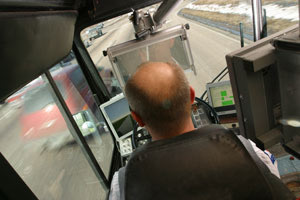Heading_1-RtCol
Paragraph Nibh euismod tincidunt; ut laoreet dolore magna aliquam erat volutpat ut wisi enim. Quinta decima eodem modo typi qui nunc nobis videntur parum clari fiant sollemnes.

Driver assistive systems

Technologies that help drivers operate vehicles efficiently and safely make up a key area of research at the Intelligent Vehicles Lab. Driver assistive systems combine sensors, data processing algorithms, and a variety of display and feedback mechanisms to support decision making, manage the cognitive demands of driving under difficult environmental conditions, and reduce driver errors that often lead to crashes.
Vision enhancement
Poor visibility is frequently cited as a contributing cause of crashes. The IV Lab has combined radar and lidar sensors, onboard geospatial databases, and head-up windshield display technology to allow drivers to operate safely in low-visibility conditions. More information
Digital mapping
High-accuracy geospatial databases are needed for many ITS applications. The IV Lab has developed techniques to rapidly create centimeter-accurate digital maps, which can be incorporated into intelligent vehicle guidance systems.
Collision warning/avoidance
Making vehicles smart enough to warn drivers of an imminent collision, or to take evasive action on their own, promises to save many lives that are currently lost due to driver inattention or driver error.
Narrow lane guidance
Guiding large buses along narrow shoulder lanes is a difficult task under optimal conditions; doing so at night or in inclement weather is even more challenging. To help bus drivers operating on the Twin Cities’ network of bus-only shoulders, the IV Lab developed a system that automatically warns drivers when they begin to depart from the shoulder lane, and is even capable of automatically keeping the bus within the lane boundaries.



